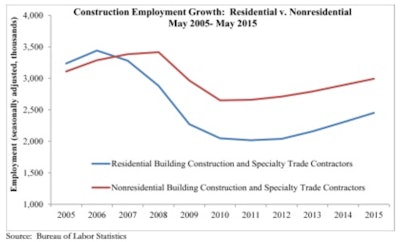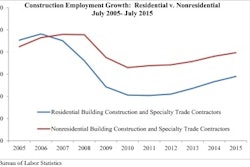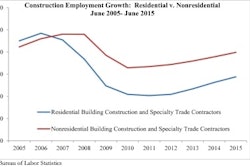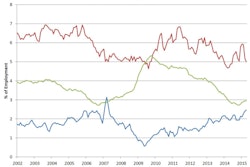
The U.S. construction industry added 17,000 jobs in May according to the June 5 preliminary estimate released by the Bureau of Labor Statistics. April's estimate was revised downward from 45,000 to 35,000 net new jobs. Nonresidential construction employment increased by 8,200 jobs in May, with nonresidential specialty trade contractors adding 5,600 jobs and nonresidential building employment expanding by 2,600 jobs. Residential construction employment added 8,500 net new jobs for the month.
"The increase in nonresidential construction employment was solid but unremarkable," said Associated Builders and Contractors Chief Economist Anirban Basu. "While some would interpret that as due to a lack of increase in demand for human capital, recent sharp increases in industry wage rates suggest that construction firms are experiencing greater difficulty locating and securing properly skilled and credentialed workers. The industry may have added more workers were human capital more readily available. Construction industry unemployment sank from 7.5 percent to 6.7 percent last month marking the second lowest industry unemployment rate since November 2007.
"The tightening of the labor market should come as little surprise as the broader economy has averaged nearly 255,000 net new jobs added per month over the past calendar year," said Basu. "The economy has added private jobs for 63 consecutive months, the longest such streak in American history. ABC expects wage pressures to build in the construction industries and the broader economy over the next year. That will produce a combination of positive and negative effects, including stronger consumer spending and rising interest rates.
"Among the report's most positive aspects was the significant entry of new job seekers into the U.S. labor market," said Basu. "Broader participation in the economic recovery is critical to achieving three percent growth or better going forward."
Construction employment for the month and the past year breaks down as follows:
- Nonresidential building construction employment grew by 2,600 jobs for the month and is up by 19,500 jobs or 2.8 percent since May 2014.
- Residential building construction employment expanded by 1,800 jobs in May and is up by 44,100 jobs or 6.8 percent on an annual basis.
- Nonresidential specialty trade contractors added 5,600 jobs for the month and employment in that category is up by 80,600 jobs or 3.7 percent from the same time one year ago.
- Residential specialty trade contractors added 6,700 net new jobs in May and have collectively added 104,900 jobs or 6.3 percent since May 2014.
- The heavy and civil engineering construction segment added 400 jobs in May, and employment is up by 24,200 positions or 2.6 percent on a year-over-year basis.
View the April 2015 employment report.


















